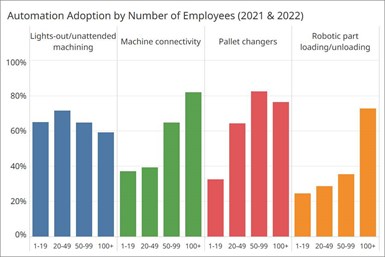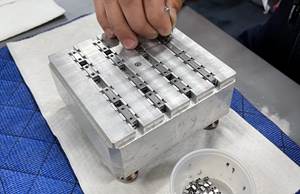The Automated Shop – A Conference and a Goal for U.S. Machine Shops
Modern Machine Shop’s upcoming technical conference will be an opportunity to learn about several types of automation that are now accessible to small- and mid-sized machine shops in the U.S.
This coming October 10 and 11, Modern Machine Shop will host TASC – The Automated Shop Conference. This technical conference is targeted toward small- and mid-sized machine shops (50 employees or fewer) on or about to take the journey toward lights-out machining and automating mid- to high-volume production.
I’ve had the chance to start thinking about a major question related to the conference: How do the shopfloor automation capabilities at large OEMs differ from those available to small and mid-sized machine shops? For context, I’m writing this column after having just returned from an extended tour of Renishaw’s three main production facilities in England and Wales. These are highly automated facilities, and I left the multi-day tour with a few impressions relevant to this question.
Renishaw is known widely as a provider of metrology systems as well as spectroscopy equipment and metal 3D printers. Across its three main production sites, the company typically machines 1.2 million parts per month. Every 30 days, Renishaw processes about 4,000 individual work orders or batches and performs around 2,800 machining operations via automated setup with no manual inputs. On top of that, the company is about to debut a new software platform designed to leverage data from connected shopfloor devices and push automation even further.
The result of these efforts, according to the company, is that its automation cells connected to the new software platform have a scrap rate of 0.22%. At its largest production plant in Miskin, Wales, the company staffs only four people per shift to oversee 43 automated machine tools.
So then, what is the difference between the automation deployed by Renishaw and the automation available to small and mid-sized machine shops?
Adoption trend among Top Shops for each of four forms of automation. Almost all trend up over time. Credit: Gardner Intelligence
The answer is that there is no difference — at least not from a pure technology perspective. Except for Renishaw’s new software platform, I did not see evidence of shopfloor automation at Renishaw that could not be implemented at a typical U.S. machine shop today.
The key differentiator is that Renishaw has a team of engineers dedicated to innovating and implementing new automation solutions to use in its own production processes. Can the average small- or mid-sized U.S. machine shop afford to hire a team of engineers to execute automation strategies? Of course not. But shop leaders can consult their peers.
This is why the time is now for an automation technology conference like TASC, where industry specialists will share their own automation strategies, and where shop owners and managers can learn from each other and focus on automation solutions that make sense for their operations. Through Modern Machine Shop’s Top Shops benchmarking data, we already know that this country’s top performing small- and mid-sized shops are automating, although in some cases not at the same levels at larger shops. What’s more clear is that higher levels of automation are associated with higher performance.
Distribution of plant sizes among adopters of each of four forms of automation. Small shops are adopting automation, some forms more than others. Credit: Gardner Intelligence
During a recent conversation with Matt Kirchner, the president of ATS/LAB Midwest who will co-chair the TASC event with me this October, Kirchner put it this way: “As somebody who was chief executive of a contract manufacturer for more than a decade, I know what it's like to get up every morning and have to figure out how to run my plan,” he said. “And the last thing I'm thinking about are the technologies that are going to disrupt me five years from now. I'm just trying to get parts out the door and adjust quality issues and manage my team. But the truth is that in the same way that technologies and advancements like standardized quality and approaches like Kaizen revolutionized manufacturing 10, 15 or even 30 years ago, that's the kind of disruption we're seeing now. We have to get ahead of it.”
Registration for the TASC event in Novi, Michigan will open later this spring. In the meantime, if you’d like to learn more or submit an application to present at conference, visit tascevent.com.
Related Content
Partial Automation Inspires Full Cobot Overhaul
Targeting two-to-four hours of nightly automation enables high-mix manufacturer Wagner Machine to radically boost its productivity past a single shift.
Read MoreLean Approach to Automated Machine Tending Delivers Quicker Paths to Success
Almost any shop can automate at least some of its production, even in low-volume, high-mix applications. The key to getting started is finding the simplest solutions that fit your requirements. It helps to work with an automation partner that understands your needs.
Read MoreChoosing a Five-Axis Machine Tool With Automation in Mind
While much focus is placed on the machinery that moves parts, the features most important for automating five-axis machining are arguably found in the machine tool itself.
Read MoreNiche Work If You Can Get It: A CNC Machine Shop Crafts Its Own Destiny
The latest innovations in metalworking aren’t always related to CNC automation or robotics. For Rosenberger North America, a 2022 Top Shops Honoree, it is the company’s niche processes that create the biggest successes.
Read MoreRead Next
The Cut Scene: The Finer Details of Large-Format Machining
Small details and features can have an outsized impact on large parts, such as Barbco’s collapsible utility drill head.
Read More3 Mistakes That Cause CNC Programs to Fail
Despite enhancements to manufacturing technology, there are still issues today that can cause programs to fail. These failures can cause lost time, scrapped parts, damaged machines and even injured operators.
Read More















.png;maxWidth=300;quality=90)












